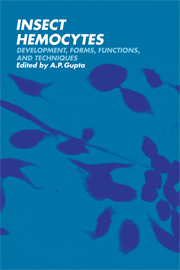Book contents
- Frontmatter
- Contents
- Preface
- List of contributors
- Part I Development and differentiation
- Part II Forms and structure
- Part III Functions
- Part IV Techniques
- 17 Identification key for hemocyte types in hanging-drop preparations
- 18 Insect hemocytes under light microscopy: techniques
- 19 Techniques for total and differential hemocyte counts and blood volume, and mitotic index determinations
- 20 Hemocyte techniques: advantages and disadvantages
- 21 Light, transmission, and scanning electron microscopic techniques for insect hemocytes
- 22 Histochemical methods for hemocytes
- Indexes
21 - Light, transmission, and scanning electron microscopic techniques for insect hemocytes
Published online by Cambridge University Press: 04 August 2010
- Frontmatter
- Contents
- Preface
- List of contributors
- Part I Development and differentiation
- Part II Forms and structure
- Part III Functions
- Part IV Techniques
- 17 Identification key for hemocyte types in hanging-drop preparations
- 18 Insect hemocytes under light microscopy: techniques
- 19 Techniques for total and differential hemocyte counts and blood volume, and mitotic index determinations
- 20 Hemocyte techniques: advantages and disadvantages
- 21 Light, transmission, and scanning electron microscopic techniques for insect hemocytes
- 22 Histochemical methods for hemocytes
- Indexes
Summary
introduction
Many technical advances have been made and new techniques developed in recent years in the field of microscopy, especially electron microscopy (EM), resulting in a tremendous expansion of our knowledge of cell substructure and function. Examples are freeze-cleave technique and improved methods for observing cells with scanning electron microscopy (SEM). Unfortunately, these new techniques have often been underutilized or sometimes ignored in the study of hemocyte structure and function. In this chapter I call attention to some of these new techniques and their essential features that should be applicable to future research on hemocytes, especially membrane studies. A comprehensive review of theory and practice of these new methods is beyond the scope of this book, and the reader is referred to the text and list of references for some of the many excellent works that cover these topics in depth.
Techniques for observing live hemocyte activities
Insect hemocytes are notorious for their ability to lyse and coagulate soon after withdrawal from the host insect. However, it is still possible to view live hemocyte activities in fresh slide preparations (Baerwald and Boush, 1971) and in tissue culture (see Chapter 9). Under ideal optical conditions, when a thin polished glass slide, ultrathin coverslip, and thin (25 μm) tissue spacers are used, a surprising amount of cell detail can be observed and photographed (Baerwald and Boush, 1971) in those hemocytes that attach to the glass and spread out completely (Fig. 21.1). Motile hemocytes do not reveal nearly as much detail as sessile hemocytes that spread completely.
- Type
- Chapter
- Information
- Insect HemocytesDevelopment, Forms, Functions and Techniques, pp. 563 - 580Publisher: Cambridge University PressPrint publication year: 1979
- 2
- Cited by



